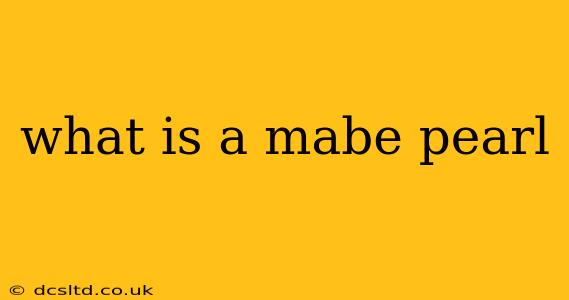Mabe pearls, often mistaken for their more famous counterparts, are unique and captivating gems that offer a distinctive aesthetic. Unlike traditionally cultured pearls formed within the oyster's soft tissue, mabe pearls are cultivated on the oyster shell's inner surface. This creates a stunning, half-pearl effect, characterized by its flat back seamlessly integrated with the shell's lustrous nacre. This guide will delve into the fascinating world of mabe pearls, exploring their creation, characteristics, and value.
How are Mabe Pearls Created?
The creation of a mabe pearl begins with a carefully selected oyster, usually a Pinctada fucata or Pinctada maxima species, known for their large size and ability to produce beautiful nacre. A small, round piece of mantle tissue (the part of the oyster that secretes nacre) is carefully grafted onto the inner shell of the oyster, along with a spherical bead, usually made of plastic or shell. The oyster then naturally coats this bead with layers of nacre, creating a pearl that is half-sphere, seamlessly attached to the shell. This process takes several months to a few years, depending on the desired size and quality of the mabe pearl. The result is a pearl that is firmly attached to its shell, unlike freely formed pearls.
What are the Characteristics of Mabe Pearls?
Mabe pearls boast several unique characteristics that distinguish them from other pearl types:
- Shape: Their defining feature is their half-round or semi-spherical shape, owing to their creation on the oyster shell. They are essentially half-pearls.
- Size: Mabe pearls can range significantly in size, from small to quite large, making them versatile for different jewelry applications.
- Luster: Like other pearls, mabe pearls can display a beautiful luster, although this can vary depending on the quality of the nacre.
- Color: The color spectrum of mabe pearls is extensive, encompassing various shades from white and cream to black, gold, and even vibrant shades of pink or green. The color is determined largely by the oyster species and its environment.
- Surface: The surface of a mabe pearl is generally smooth, although minor imperfections might be present, which is a normal characteristic for naturally cultured pearls.
What is the Difference Between Mabe Pearls and Cultured Pearls?
The key difference lies in their formation. Cultured pearls develop freely inside the oyster's body, whereas mabe pearls grow attached to the oyster's inner shell. This leads to a crucial visual distinction: mabe pearls are half-pearls with a flat back, while traditionally cultured pearls are fully spherical or nearly so. This flat back is part of the mabe pearl's unique appeal.
How Much Do Mabe Pearls Cost?
The price of mabe pearls varies considerably based on several factors, including:
- Size: Larger mabe pearls typically command higher prices.
- Color: Rarer and more vibrant colors tend to be more expensive.
- Luster: The intensity and quality of the luster significantly impact the value.
- Surface Quality: Pearls with few imperfections are valued more highly.
- Origin: The origin of the pearls can also play a role in pricing.
Generally speaking, mabe pearls are typically less expensive than similarly sized, high-quality traditionally cultured pearls. However, exceptionally large, perfectly colored, and lustrous mabe pearls can be quite valuable.
Are Mabe Pearls Real Pearls?
Yes, mabe pearls are absolutely real pearls. They are cultured pearls, meaning their formation is assisted by human intervention, but the nacre is still a natural product secreted by the oyster. The process of cultivating them is entirely natural after the initial grafting procedure.
How Can I Tell if a Mabe Pearl is Real?
Authenticating mabe pearls requires a discerning eye and sometimes professional appraisal. Look for the natural irregularities characteristic of pearls. Perfectly uniform pearls are suspicious. A professional gemologist can employ various techniques, including X-ray diffraction or other tests, to determine the authenticity of a mabe pearl.
How are Mabe Pearls Used in Jewelry?
The flat back of mabe pearls makes them ideally suited for certain types of jewelry. They are often used to create:
- Pendants: Their half-sphere shape makes them perfect for hanging pendants.
- Earrings: Mabe pearls can be beautifully incorporated into a wide array of earring designs.
- Brooches: Their unique shape is well-suited for brooches and other statement pieces.
- Rings: Mabe pearls can be used in unique ring designs, where their flat back is incorporated into the setting.
Mabe pearls offer a distinctive and beautiful alternative to traditional pearls, providing a unique aesthetic and impressive value. Their half-pearl shape and the variety of colors and sizes available make them a versatile and attractive choice for jewelry enthusiasts.
